Related Research Articles
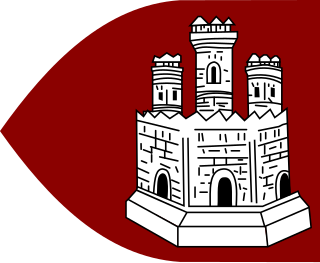
The Novgorod Republic was a medieval East Slavic state from the 12th to 15th centuries, stretching from the Gulf of Finland in the west to the northern Ural Mountains in the east, including the city of Novgorod and the Lake Ladoga regions of modern Russia. Citizens referred to their city-state as "His Majesty Lord Novgorod the Great", or more often as "Lord Novgorod the Great". The Republic prospered as the easternmost port of the Hanseatic League and its Slavic, Baltic and Finnic people were much influenced by the culture of the Viking-Varangians and Byzantine people.
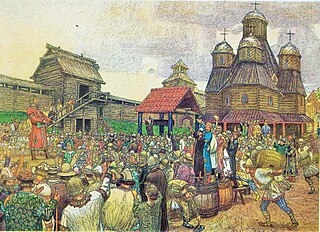
Veche was a popular assembly in medieval Slavic countries.

Posadnik (Cyrillic: посадник, was the mayor in some East Slavic cities or towns. Most notably, the posadnik was the mayor of Novgorod and Pskov. The term comes from the Old Church Slavic "posaditi," meaning to put or place; they were so-called because the prince in Kiev originally placed them in the city to rule on his behalf. Beginning in the 12th century, they were elected locally.

The Cathedral of St. Sophia in Veliky Novgorod is the cathedral church of the Archbishop of Novgorod and the mother church of the Novgorodian Eparchy.
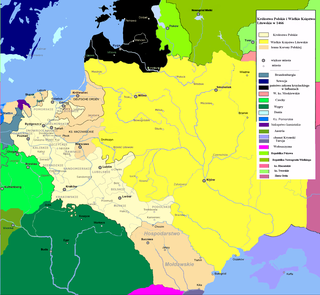
Pskov, known at various times as the Principality of Pskov or the Pskov Republic, was a medieval state on the south shore of Lake Pskov. Originally a principality and then a part of the Novgorod Republic, in 1348 Pskov became an independent republic. Its territory was roughly equivalent to the modern Pskov Oblast of Russia. The capital city, also named Pskov, was located at the southern end of the Peipus–Pskov Lake system at the southeast corner of Ugandi, about 150 miles (240 km) southwest of Nevanlinna, and 100 miles (160 km) west-southwest of Great Novgorod.
Swedish–Novgorodian Wars were a series of conflicts in the 12th and 13th centuries between the Republic of Novgorod and medieval Sweden over control of the Gulf of Finland, an area vital to the Hanseatic League and part of the Varangian-Byzantine trade route. The Swedish attacks against Orthodox Russians had religious overtones, but before the 14th century there is no knowledge of official crusade bulls issued by the pope.
The Treaty of Yazhelbitsy was a peace treaty signed by Vasili II, Grand Prince of Moscow and Vladimir, and the government of Novgorod the Great in the village of Yazhelbitsy in February 1456. This treaty was a significant setback for Novgorod, which would culminate, almost quarter of a century later, in the city being brought under the direct control of the Muscovite Grand Prince in 1478.
A tysyatsky, sometimes translated dux or herzog, was a military leader in ancient Rus' who commanded a people's volunteer army called a thousand. In the Novgorod Republic, the tysyatsky evolved into a judicial or commercial official and was elected from boyars at a veche for a period of one year. In cities with no veche, tysyatskies were appointed by the knyazs or prince from among the noble boyars and could hand down their post to their sons.

Marfa Boretskaya, also known as Martha the Mayoress, was the wife of Isaac Boretsky, Novgorod's posadnik in 1438–1439 and again in 1453. According to legend and historical tradition, she led the republic's struggle against Muscovy between her husband's death and the city's eventual annexation by Ivan III of Russia in 1478.
Valentin Lavrentievich Yanin was a leading Russian historian who authored 700 books and articles. He had also edited a number of important journals and primary sources, including works on medieval Russian law, sphragistics and epigraphy, archaeology and history. His expertise was medieval Rus' especially Novgorod the Great, where he had headed archaeological digs beginning in 1962.
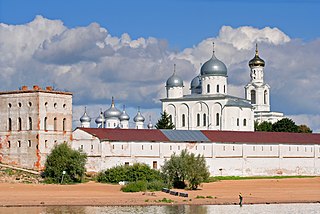
The St. George's (Yuriev) Monastery is usually cited as Russia's oldest monastery. It stands in 5 kilometers south of Novgorod on the left bank of the Volkhov River near where it flows out of Lake Ilmen. The monastery used to be the most important in the medieval Novgorod Republic. It is part of the World Heritage Site named Historic Monuments of Novgorod and Surroundings.
The Prince of Novgorod was the chief executive of Novgorod the Great. The office was originally an appointed one until the late eleventh or early twelfth century, then became something of an elective one until the fourteenth century, after which the Prince of Vladimir was almost invariably the Prince of Novgorod as well.

The Novgorod and Staraya Russa Diocese is one of the oldest offices in the Russian Orthodox Church. The medieval archbishops of Novgorod were among the most important figures in medieval Russian history and culture and their successors have continued to play significant roles in Russian history up to the present day. They patronized a significant number of churches in and around the city,, and their artistic and architectural embellishments influenced later Russian art and architecture; they also patronized chronicle-writing, a crucial source on medieval Russian history.
Ontsifor Lukinich was a posadnik of Novgorod the Great in 1350–1354. He came from a Novgorodian boyar family that gave a number of posadniks to the city. He is most famous for reforming the office in 1359, increasing the number of posadniks and creating a ruling collective in the city.
Vasilii Kalika was Archbishop of Novgorod the Great and Pskov from 1330 to 1352. He is in large part responsible for reinvigorating the office after it had fallen into decline to some extent following the Mongol Invasion.
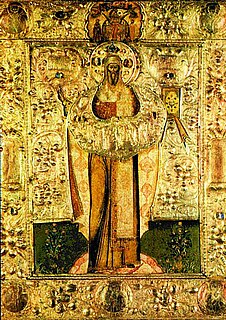
Evfimy II, Archbishop of Novgorod the Great and Pskov from 1429 to 1458, was one of the most prolific patrons of the arts and architecture of all the Novgorodian archbishops.

According to the traditional scholarship, the veche was the highest legislative and judicial authority in Veliky Novgorod until 1478, when the Novgorod Republic was brought under the direct control of the Grand Duke of Moscow, Ivan III.
The Novgorod Judicial Charter was an Old Russian legal code of the Novgorod Republic, issued in 1440, although the current version was supplemented in 1471 under the auspices of Grand Prince Ivan III, and his son, Ivan Ivanovich [1458-90; predeceased his father and never reigned] and
according to the blessing of the hieromonk Feofil who was named to the archbishopric of Novgorod the Great and Pskov, so [then] the mayors of Novgorod, and the Novgorod millenariuses, and boyars, and ranking men, and merchants, and taxpaying townsmen, all five boroughs (kontsy) [of Novgorod], [and] all Lord Novgorod the Great at assembly (veche) in Iaroslav's court

Veliky Novgorod, also known as Novgorod the Great, or Novgorod Veliky, or just Novgorod, is one of the oldest historic cities of Russia, with more than 1,000 years of history. The city serves as the administrative center of Novgorod Oblast. The city lies along the Volkhov River just downstream from its outflow from Lake Ilmen and is situated on the M10 federal highway connecting Moscow and Saint Petersburg. UNESCO recognized Novgorod as a World Heritage Site in 1992. The city has a population of 218,717 (2010 Census);

Novgorod Land was one of the largest historical territorial–state formations in Russia, covering its northwest and north. Novgorod Land, centered in Veliky Novgorod, was the cradle of Old Russian statehood under the rule of the Rurikovich dynasty and one of the most important princely thrones of the era of Kievan Rus'. During the collapse of Kievan Rus' and in subsequent centuries, Novgorod Land developed as an autonomous Russian state with republican forms of government under the suzerainty of the great princes of Vladimir. During the period of greatest development, it reached the North to the White Sea, and in the east it spread beyond the Ural Mountains. It had extensive trade relations within the framework of the Hanseatic League. In the 15th century, in the course of the grand–princely policy of "gathering Russian lands", Veliky Novgorod, with the surrounding lands, was completely annexed to the centralized Russian state. Novgorod Land existed as an administrative unit until 1708.
References
- ↑ For a brief review of the traditional literature, see Michael C. Paul, "The Iaroslavichi and the Novgorodian Veche: A Case Study on Princely Relations with the Veche," Russian History (2004).
- ↑ Valentin Ianin, Novgorodskie Posadniki (Moscow: Moscow State University, 1962; second edition Moscow: Yazyki Slavianskoi Kultury, 2003), 437; Idem, "The Archaeology of Novgorod," Scientific American 262, No. 2(Feb. 1990), 72-84.
- ↑ Jonas Granberg, “The Sovet Gospod of Novgorod, in Russian and German Sources,” Jahrbücher für Geschichte Osteuropas 47 (1998): 396-401.